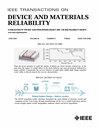Modeling of Temperature Rises at Focal-Plane-Array and Their Impact on the Performance of a CCD-Based Spaceborne Earth-Observing Imaging System
IF 2.5
3区 工程技术
Q2 ENGINEERING, ELECTRICAL & ELECTRONIC
IEEE Transactions on Device and Materials Reliability
Pub Date : 2024-04-18
DOI:10.1109/TDMR.2024.3390798
引用次数: 0
Abstract
Space optical imaging systems are subject during their in-orbit lifetime to many damaging effects caused by aging and harsh conditions (temperature and radiation) in the low Earth orbit environment threatening consequently instruments’ performance and durability. In particular, the time-dependent increase of the detector’s thermally-induced dark current due to temperature rises at the Focal-Plane-Array (FPA) may well lead to an unacceptable degradation in the radiometric performance of the optical imager. The aim of this work is to establish measures for the mitigation of FPA thermal effects on the radiometric performance and calibration of a space-borne optical imaging payload through FPA design optimization and in-orbit operation of the optical imaging payload. The temperature rises at FPA during long strip acquisition are first modeled, and results are used to assess the consequent effect on radiometric performance by predicting time-variable changes in detector offset due to thermal leakage current. Then, based on the outcomes of the thermal model and offset signals calculation, recommendations regarding FPA design and the operation of the optical imaging payload are made to mitigate the effect of FPA temperature rises on the imager’s radiometric performance. Finally, in-flight FPA temperature measurements taken during on-orbit operation are compared with the FPA thermal model results. The modeling results exhibit a strong correspondence with the measurements acquired during the flight. The dark current derived from in-flight data demonstrates that the time-dependent increase in the detector offset signals induced by temperature rises at FPA during image acquisition is negligible, validating the proposed thermal mitigation strategy.焦平面阵列温度上升模型及其对基于 CCD 的空间地球观测成像系统性能的影响
空间光学成像系统在其在轨寿命期间会受到低地球轨道环境中老化和恶劣条件(温度和辐射)造成的许多破坏性影响,从而威胁到仪器的性能和耐用性。特别是,由于焦平面阵列(FPA)的温度上升,探测器的热致暗电流随时间而增加,这很可能导致光学成像仪的辐射测量性能出现不可接受的下降。这项工作的目的是通过 FPA 设计优化和光学成像有效载荷的在轨运行,制定减轻 FPA 热效应对空间光学成像有效载荷辐射测量性能和校准影响的措施。首先对长条带采集过程中 FPA 的温升进行建模,并通过预测热泄漏电流导致探测器偏移量的时变变化来评估结果对辐射测量性能的影响。然后,根据热模型和偏移信号的计算结果,提出有关 FPA 设计和光学成像有效载荷操作的建议,以减轻 FPA 温度升高对成像仪辐射测量性能的影响。最后,将在轨运行期间进行的飞行 FPA 温度测量结果与 FPA 热模型结果进行了比较。建模结果与飞行期间获得的测量结果非常吻合。从飞行中数据得出的暗电流表明,在图像采集过程中,FPA 温度上升引起的探测器偏移信号随时间变化的增加可以忽略不计,从而验证了所提出的热缓解策略。
本文章由计算机程序翻译,如有差异,请以英文原文为准。
求助全文
约1分钟内获得全文
求助全文
来源期刊

IEEE Transactions on Device and Materials Reliability
工程技术-工程:电子与电气
CiteScore
4.80
自引率
5.00%
发文量
71
审稿时长
6-12 weeks
期刊介绍:
The scope of the publication includes, but is not limited to Reliability of: Devices, Materials, Processes, Interfaces, Integrated Microsystems (including MEMS & Sensors), Transistors, Technology (CMOS, BiCMOS, etc.), Integrated Circuits (IC, SSI, MSI, LSI, ULSI, ELSI, etc.), Thin Film Transistor Applications. The measurement and understanding of the reliability of such entities at each phase, from the concept stage through research and development and into manufacturing scale-up, provides the overall database on the reliability of the devices, materials, processes, package and other necessities for the successful introduction of a product to market. This reliability database is the foundation for a quality product, which meets customer expectation. A product so developed has high reliability. High quality will be achieved because product weaknesses will have been found (root cause analysis) and designed out of the final product. This process of ever increasing reliability and quality will result in a superior product. In the end, reliability and quality are not one thing; but in a sense everything, which can be or has to be done to guarantee that the product successfully performs in the field under customer conditions. Our goal is to capture these advances. An additional objective is to focus cross fertilized communication in the state of the art of reliability of electronic materials and devices and provide fundamental understanding of basic phenomena that affect reliability. In addition, the publication is a forum for interdisciplinary studies on reliability. An overall goal is to provide leading edge/state of the art information, which is critically relevant to the creation of reliable products.
 求助内容:
求助内容: 应助结果提醒方式:
应助结果提醒方式:


